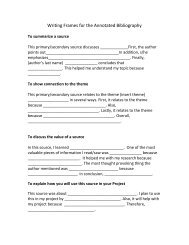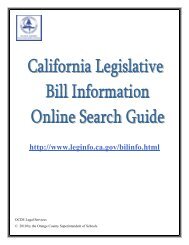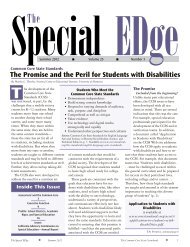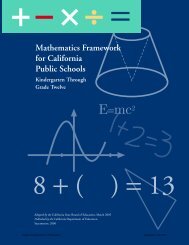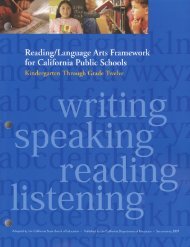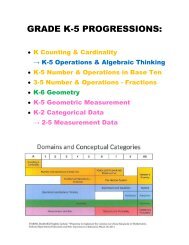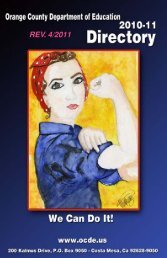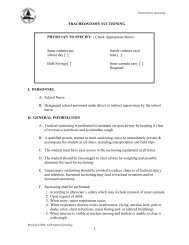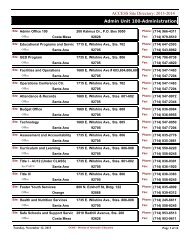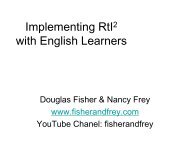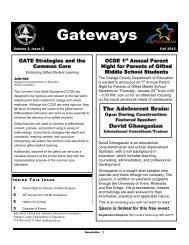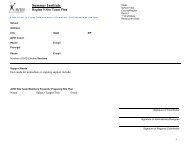Appendix B â Cognitive Rigor Matrix/Depth of Knowledge (DOK)
Appendix B â Cognitive Rigor Matrix/Depth of Knowledge (DOK)
Appendix B â Cognitive Rigor Matrix/Depth of Knowledge (DOK)
You also want an ePaper? Increase the reach of your titles
YUMPU automatically turns print PDFs into web optimized ePapers that Google loves.
<strong>Appendix</strong> B – <strong>Cognitive</strong> <strong>Rigor</strong> <strong>Matrix</strong>/<strong>Depth</strong> <strong>of</strong> <strong>Knowledge</strong> (<strong>DOK</strong>)<br />
The Common Core State Standards require high-level cognitive demand, such as asking students<br />
to demonstrate deeper conceptual understanding through the application <strong>of</strong> content knowledge<br />
and skills to new situations and sustained tasks. For each Assessment Target in this document,<br />
the depth(s) <strong>of</strong> knowledge (<strong>DOK</strong>) that the student needs to bring to the item/task has been<br />
identified, using the <strong>Cognitive</strong> <strong>Rigor</strong> <strong>Matrix</strong> shown below. This matrix draws from two widely<br />
accepted measures to describe cognitive rigor: Bloom's (revised) Taxonomy <strong>of</strong> Educational<br />
Objectives and Webb’s <strong>Depth</strong>-<strong>of</strong>-<strong>Knowledge</strong> Levels. The <strong>Cognitive</strong> <strong>Rigor</strong> <strong>Matrix</strong> has been<br />
developed to integrate these two models as a strategy for analyzing instruction, for influencing<br />
teacher lesson planning, and for designing assessment items and tasks. (To download full article<br />
describing the development and uses <strong>of</strong> the <strong>Cognitive</strong> <strong>Rigor</strong> <strong>Matrix</strong> and other support CRM<br />
materials, go to: http://www.nciea.org/publications/cognitiverigorpaper_KH11.pdf)<br />
A “Snapshot” <strong>of</strong> the <strong>Cognitive</strong> <strong>Rigor</strong> <strong>Matrix</strong> (Hess, Carlock, Jones, &<br />
Walkup, 2009)<br />
<strong>Depth</strong> <strong>of</strong><br />
Thinking<br />
(Webb)<br />
+ Type <strong>of</strong><br />
Thinking<br />
(Revised<br />
Bloom)<br />
Remember<br />
Understand<br />
Apply<br />
Analyze<br />
<strong>DOK</strong> Level 1<br />
Recall &<br />
Reproduction<br />
- Recall conversions, terms,<br />
facts<br />
-Evaluate an expression<br />
-Locate points on a grid or<br />
number on number line<br />
-Solve a one-step problem<br />
-Represent math<br />
relationships in words,<br />
pictures, or symbols<br />
-Follow simple procedures<br />
-Calculate, measure, apply<br />
a rule (e.g., rounding)<br />
-Apply algorithm or<br />
formula<br />
-Solve linear equations<br />
-Make conversions<br />
-Retrieve information from<br />
a table or graph to answer a<br />
question<br />
-Identify a pattern/trend<br />
<strong>DOK</strong> Level 2<br />
Basic Skills &<br />
Concepts<br />
- Specify, explain<br />
relationships<br />
-Make basic inferences or<br />
logical predictions from<br />
data/observations<br />
-Use models /diagrams to<br />
explain concepts<br />
-Make and explain<br />
estimates<br />
-Select a procedure and<br />
perform it<br />
-Solve routine problem<br />
applying multiple concepts<br />
or decision points<br />
-Retrieve information to<br />
solve a problem<br />
-Translate between<br />
representations<br />
-Categorize data, figures<br />
-Organize, order data<br />
-Select appropriate graph<br />
and organize & display<br />
data<br />
-Interpret data from a<br />
simple graph<br />
-Extend a pattern<br />
<strong>DOK</strong> Level 3<br />
Strategic Thinking<br />
& Reasoning<br />
-Use concepts to solve nonroutine<br />
problems<br />
-Use supporting evidence<br />
to justify conjectures,<br />
generalize, or connect<br />
ideas<br />
-Explain reasoning when<br />
more than one response is<br />
possible<br />
-Explain phenomena in<br />
terms <strong>of</strong> concepts<br />
-Design investigation for a<br />
specific purpose or<br />
research question<br />
- Use reasoning, planning,<br />
and supporting evidence<br />
-Translate between<br />
problem & symbolic<br />
notation when not a direct<br />
translation<br />
-Compare information<br />
within or across data sets or<br />
texts<br />
-Analyze and draw<br />
conclusions from data,<br />
citing evidence<br />
-Generalize a pattern<br />
-Interpret data from<br />
complex graph<br />
<strong>DOK</strong> Level 4<br />
Extended Thinking<br />
-Relate mathematical<br />
concepts to other content<br />
areas, other domains<br />
-Develop generalizations <strong>of</strong><br />
the results obtained and the<br />
strategies used and apply<br />
them to new problem<br />
situations<br />
-Initiate, design, and<br />
conduct a project that<br />
specifies a problem,<br />
identifies solution paths,<br />
solves the problem, and<br />
reports results<br />
-Analyze multiple sources<br />
<strong>of</strong> evidence or data sets<br />
68 (December 7, 2011 v7.8) – DRAFT: Only for review and feedback from SBAC members and interested stakeholders
Evaluate<br />
Create<br />
- Brainstorm ideas,<br />
concepts, problems, or<br />
perspectives related to a<br />
topic or concept<br />
-Generate conjectures or<br />
hypotheses based on<br />
observations or prior<br />
knowledge and experience<br />
-Cite evidence and develop<br />
a logical argument<br />
-Compare/contrast solution<br />
methods<br />
-Verify reasonableness<br />
-Develop an alternative<br />
solution<br />
-Synthesize information<br />
within one data set<br />
-Apply understanding in a<br />
novel way, provide<br />
argument or justification<br />
for the new application<br />
-Synthesize information<br />
across multiple sources or<br />
data sets<br />
-Design a model to inform<br />
and solve a practical or<br />
abstract situation<br />
69 (December 7, 2011 v7.8) – DRAFT: Only for review and feedback from SBAC members and interested stakeholders




